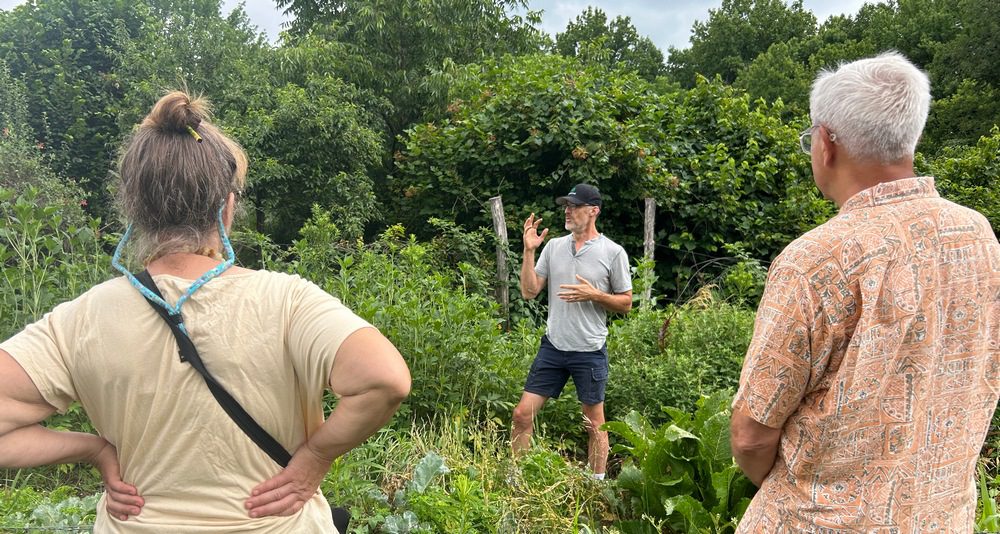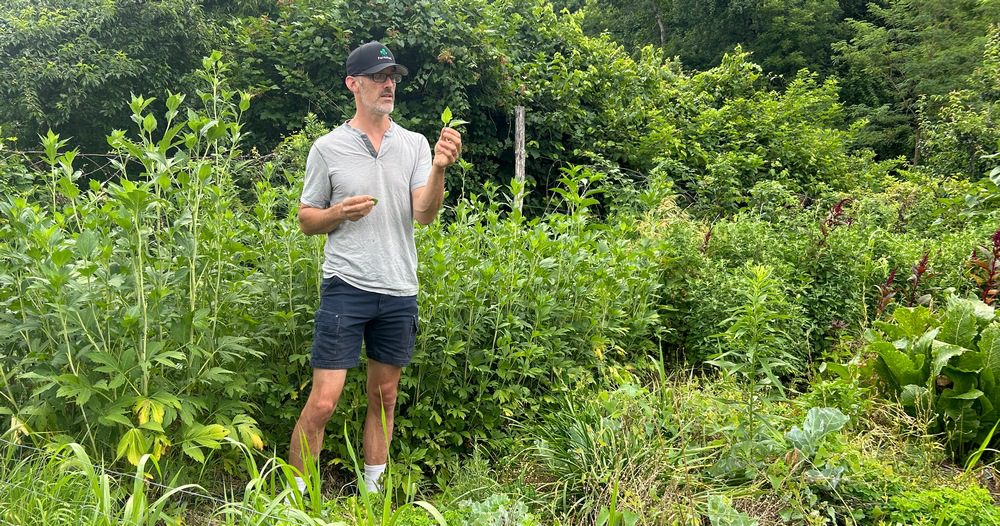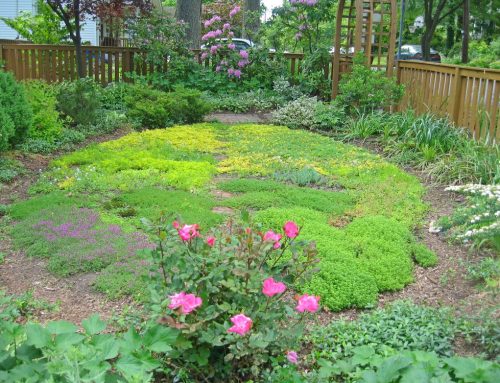
Lincoln Smith speaking to members of the Greenbelt-Beltsville Garden Club in his forest garden.
Lincoln Smith has been described, by one Washington Post reporter, as a “landscape architect gone rogue,” after he quit his “high-end landscape architecture firm” to experiment and advance forest agriculture, the goal proclaimed on his website.

He started his “forest garden” in 2012 on 10 acres of former cornfield that he leases from the church he’s attended since childhood, located in Bowie, Maryland (very near me).
Is it Permaculture? How about Agroecology?

Ah words.“Permaculture” and “Agroecology” mean pretty similar things. I personally prefer “agroecology.”“Forest garden” = “Edible Forest Garden” = “Food Forest”Forest gardening is a form of agroecology suitable for the forest biome. For the grassland biome, forest gardens are not appropriate – agroecology systems based on the grassland are called for. But here in the eastern U.S., this is a forest, so we need forest gardens to restore ecosystem health while feeding people.
So here Lincoln and his team are experimenting with what grows best – on this very land – with the least amount of inputs, including labor. So they measure their yields – it’s citizen science! They’re producing food and restoring the ecosystem at the same time! Lincoln has heard the doubters and skeptics and seems to answer to them at the end of Forest’s 10-year anniversary video.
Small forest garden projects like this are not going to individually change the world but I think every project does have a role to play in increasing our knowledge and increasing the conversation about how we can better work with and benefit from the ecosystems where we live…
It’s a lifetime of discovery and excitement to figure out the plants and the culture around those plants that can take us to a future where hopefully our ecosystems are restored at the regional scale, wildlife habitat is improved, water quality is improved, and people are eating better so that they are more healthy and more integrated with their local ecosystem, the amazing forests of the Eastern United States.
The first task was to heal the soil, made low in organic matter by years of corn production. “Over time…the forest’s productivity could begin to rival that of conventional farms.” He calculates that mature red oak trees can churn out as many calories per acre in the form of acorns as can wheat. For those willing to wait, “the forest works…This ecosystem is incredibly productive … and there is a tremendous amount of yield potential there that we can tap into.” …Studies have even found higher insect diversity in forest gardens than in native forests allowed to grow ‘on their own.’” Source.
The Plants – what’s worked so far, and what hasn’t
They native oaks grown here are the ones with the largest acorns. Harvesting and processing them is very labor-intensive.


Dried persimmons. Photo by Lincoln Smith.
Mulberry trees can keep birds from eating blueberries. They’ve found that the Illinois Everbearing Mulberry is the best. It’s super-easy and very productive.
Aronia is a very productive native plant.
They grow the easy wild gooseberries, which are smaller than the cultivated type.
Lincoln calls highbush cranberry “pretty nasty” and black chokeberry “bitter,” and he hasn’t found any native cherries that he likes.

Yaupon Hollies are great! In this photo Lincoln is showing us the contraption that dehydrates the leaves before roasting, resulting in a “great tea.” It’s the only native plant with caffeine; the tea can be ordered online. (And here I assumed Yaupons were Asian, because of the name.) But note that the berries are toxic to humans; it’s the leaves that are edible.
For vegetables, they choose the ones requiring the lowest possible maintenance. Sunchoke is a terrific root crop that’s low-care, as is squash. They’ve tried potatoes but have had more success with sweet potatoes. It’s all about minimizing labor.
Ostrich fern is Lincoln’s favorite shade vegetable.
Lamb’s quarters are great to eat, similar to spinach.
Baptisia is grown here because it’s a so good at fixing nitrogen.
Mimosa, an invasive plant that was on the property already, is left in place and treated with a Permaculture technique called chop and drop. Comfrey is treated the same way.

When the garden started, Japanese beetles were a huge problem. But right out of an organic gardening textbook, the problem was brought under control by planting goldenrods, which attract the Blue Wing Wasps, which eat the beetles. Amazing how that works! Photo above from Forested’s 10-year anniversary video.

Here Lincoln is holding edible Black-eyed Susans. (Honestly, I’m so tick-phobic, it freaked me out to see him stomping through high plants with uncovered arms and legs!)
Design/Techniques

Lincoln demonstrates his sythe technique in Forested’s 10-year anniversary video.
Lincoln told us he doesn’t like “inaccessible forest gardens,” so it’s important to mow the paths. With no plant encroachments over the paths, visitors feel safe, not claustrophobic. “It’s a people habitat.” He’s found that white clover is perfect for paths because it can take mowing – while at the same time fixing lots of nitrogen. The taller red clover is also great at improving soil and is grown in unmown parts of the garden.
He uses a traditional sythe to hack the undergrowth back as needed.
For peaches and apples he uses the clay-based Surround, which unfortunately deters all insects.
Lincoln is cautiously open to the use of GMO technology in the effort to produce blight-resistant American chestnuts.
The wildly invasive tree Bradford pear was already on the property, but guess what – it makes an excellent root stock for Asian and European pears! The graft results in easy, trouble-free pear trees, fruiting the very next year. (Lincoln’s article for Washington Gardener Magazine explains the grafting process.)
My Opinion of Permaculture/Agroecology does a 180!
Okay, I’ll admit that I was a skeptic, and not the only skeptic in our group. That’s because you hear a lot of kooky things about permaculture, largely thanks to the 1978 book that popularized that term and set forth rigid design “guilds” and other strict prescriptions. It was written by two men in Tasmania, over 10K miles away from here.
So it was a nice surprise that Lincoln’s exploration of what works on this specific plot of land won us over, big-time! Even purists were so impressed with the scope of what he’s discovering and its potential to be useful in known and unknown ways, they give him a pass on using invasive Bradford pears and being open to plants from anywhere, and technology, too.
About using the hated Bradfords that predate him on the land, Lincoln says it’s like “Like catfish in the bay.”
I love what’s happening at Forested because they’re advancing forest agriculture in the only way it really can be advanced – by observing the land, not by following any rigid ideology, and notably not by blaming humans as innately harmful beings whose needs should have no place in the world. Lincoln’s attitude – “It’s a people’s habitat” – sets him apart. Instead of trying to banish humans from nature, this forest garden welcomes us into a healthy, mutually beneficial partnership with it.
If you’re wondering how Lincoln is making this work financially, he says “The majority of my not-very-good-but-improving income is from designing, installing and maintaining public and private edible forest gardens for clients. The garden in Bowie is our test best; most of our clients visit it before they hire us.”
Agroecology in the Garden?
As impressive as Lincoln’s innovative research is, you may also be wondering: how applicable is it to gardeners?
Well, I know some of you would like to grow edibles but can’t commit to tending the typical high-maintenance veg garden, for a variety of good reasons. With knowledge of super-easy edibles like gooseberries and cut-leaf coneflowers, more of us might do it. That goes for people who want to dine on the harvest as well as people like me who’d happily leave the fruits and berries for wildlife to consume.
And how to incorporate “forest garden” plants and techniques into residential or even a public garden, where aesthetics are important to some degree? I’ve asked Lincoln for examples nearby that I can visit – both residential and public spaces – and I’ll be sharing the results here.
Stay tuned.






Enjoyed the trip through the ‘Forest’ but have a question…I live in zone 7b the books say, though many zone 7 plants don’t make it here so I think I am in the tiny dot in the center of VA that is zone 6. I liked the idea of using goldenrod to help manage the Japanese beetles, however, my goldenrods don’t bloom until the beetles are gone. Since they draw the wasp I would think it was the flowers that drew them…what is the situation here.
I use Surround on my fruit and it is used only after the fruit has formed, so pollinators are not impacted and it only needs to be re-applied after heavy rains until about the 3rd week in June after which other fruit borers are gone. I have many Eastern Cedars here and without the Surround apple cedar rust would mean no edible apples! Surround is also helpful on squash and cukes when they are first transplanted or first come up if seeded in to keep the Squash bugs off. They don’t care for the taste of Kaolin clay it appears!
love it now I know what my backyard is: a forest garden I deliberately over 25 years let all trees which popped up remain, well not all…I did cull some mulberry, redbud and holly but only to let the oaks, hackberry, Ky coffee trees and native apples get more light. I did this in an attempt to screen out the annoying security lights of the school which abut my lot. It works beautifully and now I can concentrate on making it a true “forest garden.” i am re-evaluating the berries that i used to consider a nuisance.
Very cool! I wonder if the many black walnut trees in this area have a place in these agro-forests. I have several black walnuts in my backyard and have always felt it’s a shame that such a huge quantity of valuable food is dropped at my feet every fall but that it’s so hard to access because of those damn husks…
Thank you for a wonderful look into a grand project worth celebrating. Congratulations to Lincoln Smith for Forested’s 10th Anniversary. He has created an agroecological garden we can learn from, and Susan has done a great job examining what it represents; including science, history, and hope.